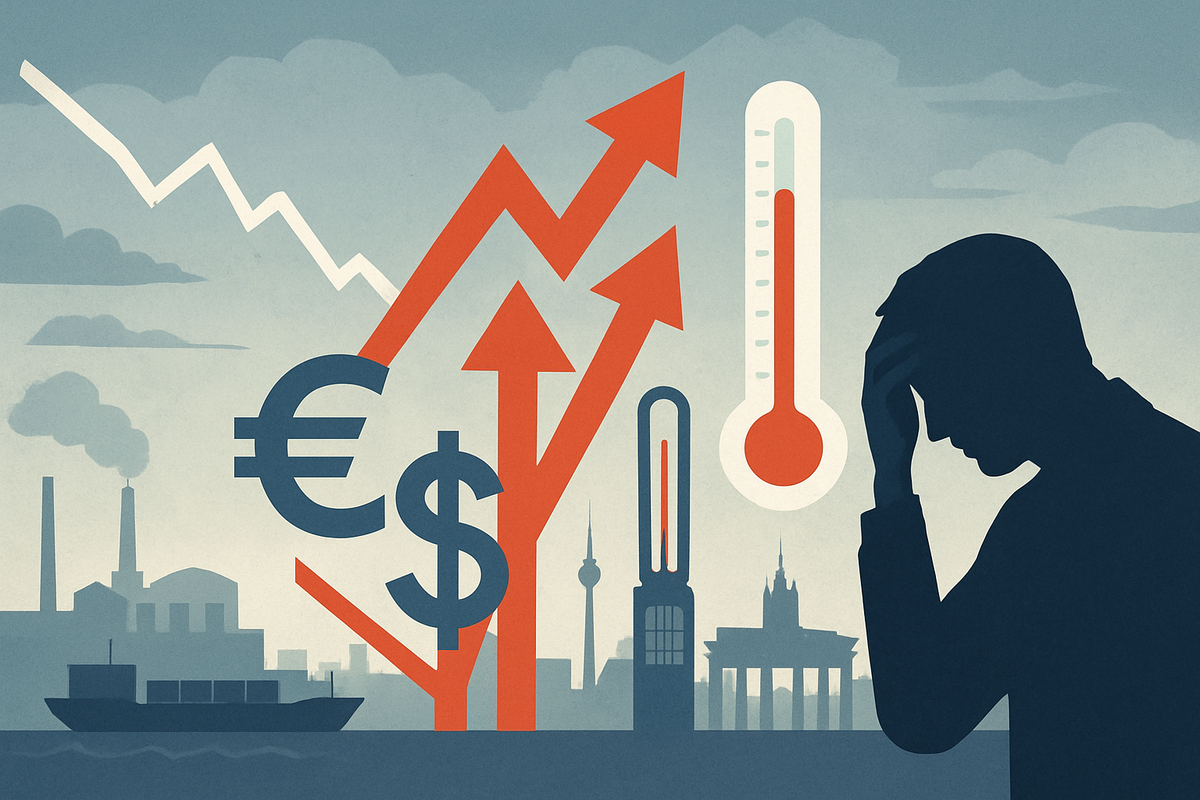
Germany, the economic powerhouse of Europe, is currently navigating a challenging period marked by a persistent rise in its annual inflation rate and a significant deterioration in economic sentiment. As of September 2025, the nation's annual inflation rate, measured by the Consumer Price Index (CPI), climbed to +2.4%, marking the highest rate recorded this year and an increase for the second consecutive month. This inflationary pressure, coupled with a palpable sense of pessimism among businesses and consumers, casts a long shadow over the immediate future of the German economy and poses potential ripple effects across European and global financial markets.
The confluence of elevated prices and eroding confidence points to a deepening macroeconomic crisis. While the European Central Bank (ECB) strives to maintain price stability, Germany's struggle with inflation above the 2% target complicates monetary policy decisions and dampens hopes for near-term easing. The immediate implications include a likely continuation of economic stagnation, weakened domestic and external demand, and a further erosion of consumer purchasing power, all of which contribute to a cautious outlook for investment and growth.
Germany's Economic Headwinds Intensify Amidst Persistent Inflation
The recent uptick in Germany's annual inflation rate to +2.4% in September 2025 is a critical development, signaling a concerning trend after months of relatively stable, albeit elevated, price levels. This increase is primarily driven by above-average price hikes in the services sector, which rose by 3.4% in September, a noticeable acceleration from previous months. While the decline in energy prices has slowed significantly, offering less relief to overall inflation, food prices also contributed to the upward pressure, increasing by 2.1%. Even the core inflation rate, which excludes volatile food and energy components, saw a slight rise to +2.8%, indicating broad-based price pressures within the economy.
This inflationary environment is compounded by a stark deterioration in economic sentiment. The ZEW Economic Sentiment Index, a forward-looking indicator, showed a slight improvement in expectations for the next six months in October 2025. However, the Current Situation Index plummeted to -80, its lowest level since May, reflecting a profoundly negative assessment of present economic conditions by financial analysts. Similarly, the Ifo Business Climate Index, a crucial gauge of business confidence, decreased to 87.7 in September 2025, marking its lowest point since May and the sharpest monthly drop in over a year. This widespread pessimism among businesses regarding both their current situation and future prospects is a significant red flag. Consumer confidence, as indicated by the GfK Consumer Climate Indicator, also remains weak, with declining economic expectations and a reduced willingness to buy, pushing consumers towards increased saving rather than spending.
The timeline leading up to this point reveals a gradual but concerning trajectory. Following two consecutive years of economic contraction, Germany's economy has struggled to regain momentum. The current macroeconomic crisis is considered deeper than previous downturns, influenced by lingering effects of the pandemic, ongoing geopolitical instability, and a series of cost shocks. High financing and construction costs have crippled the construction industry, while weak global demand, exacerbated by international conflicts and high inflation in key trading partners, has reduced foreign demand for German industrial goods and exports. Key stakeholders, including the German government, the European Central Bank (ECB), and various industry associations, are closely monitoring the situation, with calls for targeted policy interventions and a clear strategy to restore confidence and foster growth. Initial market reactions have been cautious, with equities showing volatility and bond yields reflecting investor concerns about future economic performance and potential monetary policy responses.
Companies Poised to Win or Lose Amidst German Economic Turmoil
Germany's current economic climate, characterized by rising inflation and deteriorating sentiment, creates a mixed bag of fortunes for public companies, both domestically and internationally. Some sectors and companies are likely to face significant headwinds, while others might find opportunities amidst the challenges.
Companies heavily reliant on consumer spending, particularly in non-essential goods and services, are likely to be among the biggest losers. The erosion of purchasing power due to inflation and the decline in consumer confidence, as evidenced by the GfK Consumer Climate Indicator, will directly impact sales volumes. Retailers like Zalando SE (FWB: ZAL) and automotive manufacturers such as Volkswagen AG (FWB: VOW3) and Mercedes-Benz Group AG (FWB: MBG) could see reduced demand for their products as consumers tighten their belts. High energy costs, while showing a slower decline, continue to impact energy-intensive industries, reducing profit margins for manufacturers that cannot fully pass on these costs to consumers. Export-oriented industrial companies, such as engineering giants like Siemens AG (FWB: SIE), may also suffer from weakened global demand and a loss of price competitiveness due to various cost shocks and the appreciation of the euro's effective exchange rate. The construction sector is particularly vulnerable, with high financing and construction costs stifling activity, negatively impacting companies like Heidelberg Materials AG (FWB: HEI).
Conversely, some companies might find themselves in a relatively stronger position. Discount retailers and providers of essential goods could see increased demand as consumers prioritize value. Companies offering services that are less discretionary or benefit from structural trends might also fare better. Businesses with strong pricing power, able to pass on increased costs to consumers without significant loss of demand, will be more resilient. Technology companies focused on efficiency solutions or digital transformation, for instance, might see sustained demand as businesses look to optimize operations in a challenging environment. Furthermore, companies with robust balance sheets and diversified international operations may be better equipped to weather the domestic downturn by leveraging growth in other markets. For instance, pharmaceutical companies like Bayer AG (FWB: BAYN) or those in stable utilities sectors might experience more consistent demand, offering a defensive play for investors. Financial institutions like Deutsche Bank AG (FWB: DBK) could face pressure from increased loan defaults if the economic situation worsens, but might also benefit from higher interest rate margins if the ECB maintains a hawkish stance to combat inflation.
Broader Implications and Historical Parallels
The intensifying economic challenges in Germany extend far beyond its borders, posing significant ripple effects for the broader European and global markets. As the largest economy in the Eurozone, Germany's performance has a profound impact on its trading partners and the overall stability of the single currency bloc. A prolonged period of stagnation or recession in Germany would inevitably drag down economic growth across the Eurozone, impacting countries heavily reliant on German demand for their exports. This could lead to a broader slowdown in European industrial output and an increase in unemployment across the continent. Competitors within the Eurozone, particularly those in manufacturing, might face intensified competition for dwindling demand, while partners could see a reduction in trade volumes.
The situation also has significant regulatory and policy implications. The European Central Bank (ECB) is caught in a delicate balancing act, needing to address persistent inflation while simultaneously being mindful of the deteriorating economic sentiment in its largest member state. The pressure on the ECB to maintain a hawkish stance to combat inflation, as indicated by the rising core inflation rate, could further constrain economic growth by keeping borrowing costs high. This could lead to calls for more targeted fiscal policies from the German government and the EU to stimulate demand and support vulnerable sectors, potentially leading to debates over fiscal rules and national debt levels. Globally, a weaker German economy could contribute to a slowdown in international trade, affecting global supply chains and commodity markets.
Historically, Germany has faced periods of economic stagnation and inflationary pressures, though the current confluence of factors—post-pandemic recovery, geopolitical instability, and energy shocks—makes this downturn particularly complex. Comparisons can be drawn to periods of high oil prices in the 1970s or the challenges faced during the reunification era, where structural adjustments were necessary. However, the current environment is unique due to the interconnectedness of global economies and the specific nature of recent supply-side shocks. The resilience of German industry and its capacity for innovation will be tested, as will the effectiveness of monetary and fiscal policies in navigating these unprecedented waters. The current situation highlights the vulnerabilities of export-oriented economies to global shifts and the critical need for diversification and resilience in domestic demand.
Navigating the Path Ahead: Short-Term Challenges and Long-Term Adaptations
The immediate future for Germany's economy is fraught with challenges, as the nation grapples with persistent inflation and a deepening sense of economic pessimism. In the short term, the primary focus will remain on managing inflationary pressures. The European Central Bank (ECB) is likely to maintain a cautious stance, with little room for immediate interest rate cuts, which will continue to impact borrowing costs for businesses and consumers. This environment suggests that economic stagnation is likely to persist through 2025, with any significant recovery pushed further into the future. Businesses will need to prioritize cost control, supply chain resilience, and potentially explore new markets to offset weakened domestic and European demand. Consumers, facing eroded purchasing power, are expected to remain cautious, further dampening private consumption.
Looking further ahead, the long-term possibilities involve a necessary strategic pivot for the German economy. The current crisis underscores the need for structural reforms to enhance competitiveness and reduce reliance on volatile external factors. This could include accelerated investments in renewable energy to mitigate future energy price shocks, digitalization initiatives to boost productivity, and diversification of export markets. Companies may need to adapt by focusing on high-value-added products and services, investing in automation, and fostering innovation to maintain their global standing. Market opportunities may emerge in sectors that offer solutions to these challenges, such as green technologies, cybersecurity, and advanced manufacturing.
Potential scenarios range from a gradual, albeit slow, recovery if global economic conditions stabilize and inflation recedes, to a more prolonged period of stagflation if price pressures remain stubbornly high while growth remains subdued. A critical factor will be the effectiveness of government policies in stimulating investment and confidence, alongside the ECB's ability to steer inflation back to its target without stifling growth. Investors should watch closely for shifts in central bank rhetoric, government stimulus packages, and key economic indicators like business confidence and industrial production figures. The resilience of Germany's export sector and its capacity to innovate will be crucial in determining the speed and strength of its eventual recovery.
A Critical Juncture for Germany and Global Markets
Germany's current economic predicament, characterized by stubbornly high inflation and a pervasive sense of pessimism, marks a critical juncture not only for the nation itself but for the broader European and global financial landscape. The September 2025 inflation rate of +2.4%, coupled with deeply negative assessments of current economic conditions by both businesses and financial analysts, underscores a significant challenge that extends beyond mere cyclical fluctuations. The key takeaways from this event are clear: Germany is facing a deeper, more structural economic crisis influenced by a complex interplay of post-pandemic recovery pains, geopolitical instability, and persistent supply-side cost shocks.
Moving forward, the market will be defined by uncertainty and the delicate balancing act required from policymakers. The European Central Bank's efforts to curb inflation while avoiding a severe recession will be under intense scrutiny. Investors should anticipate continued volatility in European equities and bond markets, as economic data releases and central bank pronouncements dictate sentiment. Companies with strong fundamentals, pricing power, and diversified revenue streams are better positioned to weather the storm, while those heavily reliant on discretionary consumer spending or energy-intensive operations may face sustained pressure.
The lasting impact of this period could reshape Germany's economic model, potentially accelerating its transition towards a more resilient, diversified, and sustainable economy. However, the immediate future demands vigilance. Investors should closely monitor core inflation trends, the evolution of business and consumer confidence indicators, and any policy responses from Berlin and Frankfurt. The ability of Germany to navigate these turbulent waters will serve as a crucial barometer for the health of the entire Eurozone and will undoubtedly influence global economic stability in the months and years to come.
This content is intended for informational purposes only and is not financial advice




